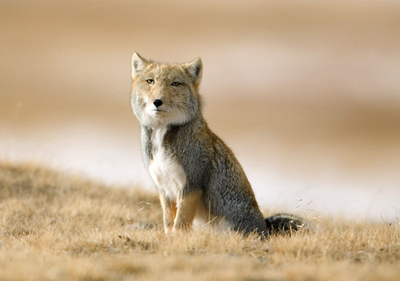Tibetan Fox (Vulpes ferrilata) - Wiki Tibetan Fox
From Wikipedia, the free encyclopedia
[Photo] Tibetan Fox. Source: U.S. Fish & Wildlife Service. Date: April 8, 2005. Photographer: Jim Frates
The Tibetan Fox (Vulpes ferrilata), also called the Tibetan Sand Fox or simply the Sand Fox, is a species of true fox that inhabits the high Tibetan Plateau in Nepal, China, and India, up to altitudes of about 5300 m. The fox was first described by the British naturalist Brian Houghton Hodgson in 1842. It has the highest sound sensitivity of all foxes.
Physical description
The Tibetan Fox is one of the smaller fox species. It has thick, soft fur that protects it from the winds of the high mountains, with a dense undercoat that is brown to rusty yellow in color. The fur on the sides and rump is colored gray. The tip of the tail is white. The body has a length of 50 to 70 cm from head to body and a tail length of 29 to 40 cm. Weight ranges from 3 to 4 kg.
The Tibetan Fox's karotype is made up of 36 chromosomes.
Behavior
Mated pairs remain together for life and also hunt together. The mating season begins in late February and ends in late March.
After a gestation period of about 50 to 60 days, two to four young are born in a den, and stay with the parents until they are eight to ten months old. Shortly after leaving they will search for mates and territory of their own.
In contrast to other fox species, Tibetan foxes are not highly territorial, so they may be found near other foxes.
Diet
Tibetan Foxes feed on rodents, ground birds, and lagomorphs.
A 1998 dropping analysis of 113 fox droppings to determine the Tibetan Fox diet showed a content of 95 percent black-lipped pika (Ochotona curzoniae) (a rabbit) and 2.7 percent Tibetan antelope (Pantholops hodgsonii), most likely scavenged. The remainder consisted of insects, bird feathers, and plants, including Ephedra berries. A previous study in 1986 showed Tibetan woolly hare (Lepus oiostolus) and a lizard of the Phrynocephalus genus, while a separate study the previous year of 158 droppings in the Qinghai Province of China noted additional content, including Himalayan marmot (Marmota himalayana), Bharal (Pseudois nayaur), Himalayan Musk Deer (Moschus chrysogaster), and livestock.
Trivia
The first time the Tibetan Fox was caught on camera was for the BBC series Planet Earth in 2006.
http://en.wikipedia.org/wiki/Tibetan_Fox
| The text in this page is based on the copyrighted Wikipedia article shown in above URL. It is used under the GNU Free Documentation License. You may redistribute it, verbatim or modified, providing that you comply with the terms of the GFDL. |
